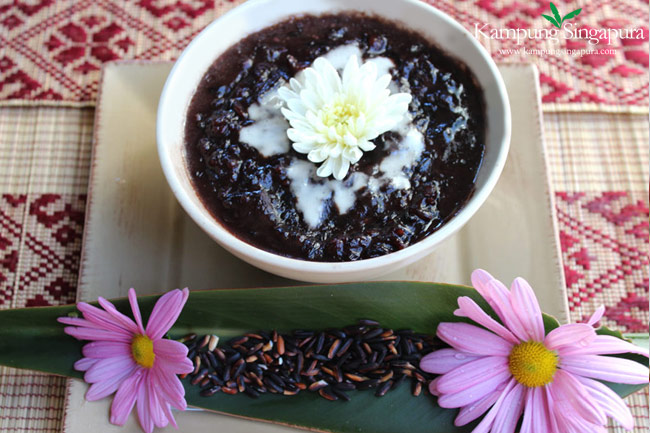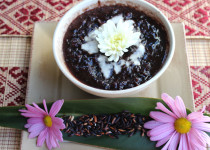
View Recipe Details Below
“Bubur Pulut Hitam“ refers to Black Glutinous Rice porridge. It is a very popular dessert in Singapore and Malaysia made with black glutinous rice, coconut milk and palm sugar. However, you will find variations to the dessert in other parts of South East Asia as well. For an example in China, the black glutinous rice is used to make sweet dumplings called “tangyuan“. In Philippines, they have “Ginataan” similar to Bubur Pulut Hitam but it has other ingredients such as jackfruits, sweet potatoes and sago pearls. Likewise, in Laos, it is called “Khao Tom“. In Korea, black glutinous rice is used to make rice cakes referred to as “chalddeok“. (Source:Wikipedia)
Black Glutinuous rice is often referred to as “sticky rice”, “sweet rice” or “waxy rice” (Source:Wikipedia). 85% of Asia specialise in cultivating this rice. It is an unpolished grain belonging to a short grain variety It is dark purple in colour and the hues become more noticeable once the rice starts cooking. It is also known to contain numerous health benefits. It is a rich source of vitamins, minerals and has a high amount of fibre (Source:CanopyAvenue).. This is one of the reasons why it is eaten as a staple dish in Laos.
This recipe is from my maternal aunt yet again. She is the Queen of Asian desserts to me at least. This version is one of Hasan’s and my personal favourites too. Usually I will cook dinner and serve this for dessert but he will literally beg me for the Bubur Pulut Hitam first and in the process of eating it, the dinner gets forgotten. =)
Bubur Hitam

Ingredients:
- Black Glutinous Rice - 200 gm (soaked overnight preferrably in water)
- Gula Melaka (Palm Sugar) - 125 gm
- Coconut Milk - 270 ml (Add more if you prefer a richer taste)
- Water - 6 cups
- Pandan Leaves (Screwpine leaves) - 3 pieces torn into halves and knotted
Instructions:
- Wash the rice thoroughly.
- Drain and place the rice in a saucepan filled with 5 cups of water and the knotted pandan leaves. The pandan leaves give fragrance and flavour to the dessert.
- Bring it to boil first and then lower the heat to let it simmer. Stir in between 6 minute intervals to make sure the rice does not stick to the pan and the water level does not reduce too much. You are aiming at a not too thick and at the same time not too thin consistency.
- Meanwhile, heat another saucepan, combine the gula melaka with the remaining 1 cup of water and stir on low heat till the sugar dissovles completely and you can see a thick syrup forming.
- Check on your black glutinous rice. It is cooked when the rice looks soft and plump.
- Add the gula melaka mixture and coconut milk and give it two stirs. Bubur Pulut Hitam ready to be served =)
*You may garnish it with dessicated coconut. I usually prefer to have more coconut milk by my side and add it in when I am eating the dessert.




We have something like this in the Philippines too - we call it Champo Rado. I loved it as a kid and still love this type of dessert now! Anything with coconut and I’m sold!
Hi Jeff,
That’s very interesting. Our dishes seem so similar. Only the names are different. I remember having a fish stew in a Filippino restaurant and it tasted the same as our ‘lontong’. I will definitely be posting more recipes with coconut ingredients soon. Look out for them. =)
This is the only Asian dessert I eat!
It is my favourite too
Well im a Filipino residing here in SG. At first glance its like our Champo Rado but its Not. Both are good. But Champorado is made of white glutinous rice plus cocoa or Chocolate powder and brown sugar but Bubur Hitam is made of Black Glutonous Rice. The only thing similar is that both use cocunut milk. The taste not similar. Filipinos may like bubur hitam like me if your missing Champo Rado cause it has the same feel coz of the color and coconut but taste not the same really. Singaporean may not like Champo Rado coz its too sweet for their taste but for us filipinos its a winner. But i do love Bubur Hitam too:)